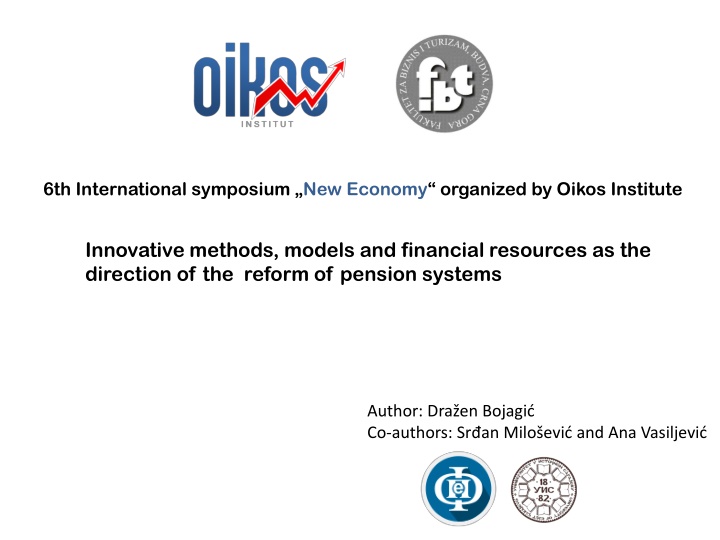
Innovative Methods and Models in Pension System Reforms
Explore the insights from the 6th International Symposium on New Economy organized by Oikos Institute, focusing on innovative methods, models, and financial resources for reforming pension systems. The analysis includes a comparison of pension systems in Chile, Germany, and the USA, along with potential strategies for application in the Republic of Srpska. Delve into the evolution and structure of Germany's pension insurance system, featuring three levels of coverage and mandatory subsystems. Discover the various levels of care provision for old age, including company-provided plans, self-care private options, and government-subsidized plans like "Riester" and "R.rup". Key indicators and challenges related to public pension expenditure and demographic trends are also outlined.
Download Presentation

Please find below an Image/Link to download the presentation.
The content on the website is provided AS IS for your information and personal use only. It may not be sold, licensed, or shared on other websites without obtaining consent from the author. If you encounter any issues during the download, it is possible that the publisher has removed the file from their server.
You are allowed to download the files provided on this website for personal or commercial use, subject to the condition that they are used lawfully. All files are the property of their respective owners.
The content on the website is provided AS IS for your information and personal use only. It may not be sold, licensed, or shared on other websites without obtaining consent from the author.
E N D
Presentation Transcript
6th International symposium New Economy organized by Oikos Institute Innovative methods, models and financial resources as the direction of the reform of pension systems Author: Dra en Bojagi Co-authors: Sr an Milo evi and Ana Vasiljevi
content We have been analyzing pension systems of Chile, Germany and USA, as well as the methods and models of funding those systems and possibilities of their appliance in Republic of Srpska.
The first social security system was established in 1889. Oto Bizmark Today the pension insurance system functions as a system of three levels The first level is consisted of subsystems that operate on the basis of legal standards which are required for a particular group of persons Approximately 85% of employees are included in the system of public pension insurance Civil servants, who form part of about 9% of the workforce have "their" pension system as well as those self-employed who choose a certain type of private insurance, provided that they have the opportunity to be part of the public pension system of Germany Generally speaking, there are four mandatory subsystem of this type
The second level of care provision is consisted of provision in oldages from the company -Direct pension promise, -Download employee life insurance policies, -"Pensionskasse" -Pension funds for this type of insurance and -Funds for support. The third level of protection in the oldages is consisted of self-care private mode which is also voluntary These private plans include (but they are not limited to) plans "Riester" and "R rup" "Riester" - subsidized by the Government, is suitable for those with lower incomes, and it also can be a classic, unique, bank savings plans and two types of contracts on construction loans The resulting pension amount is 100% taxable
R rup 'pension plan is more flexible compared to the previously mentioned and is suitable for those self-employed. There are three varieties: classic, unique and direct When a person withdraws from a pension fund, a certain percentage of the pension is taxed. In 2016 it was 74% of the amount of pension benefits Key indicators: Germani OECD Average salary 47.809 34.803 EUR USD 50.307 36.622 The expenses of public pensions 10,1 8,2 % of GDP Life expectancy 81,3 80,9 The population above 65 year old % working age population 34,8 27,9 Key issues: demographic situation, the growth of public pension expenditure, informal work, lack of labour (secondary education level)
Retirement system and types of US retirement plans The holders of funds which today control $131 trillion are: 34% 35% 1% 5% 25% Pension funds insurance funds Sovereign welth funds Endowments and foundations Joint funds
A pension plan has two primary elements: The future liabilities, or benefit obligations, created by employee service. The pension fund, or plan assets,that are used to pay for retiree benefits. Funded Status = Plan Assets - Projected Benefit Obligation
Types of retirement plans: IRAs 401(k)s and other employer-sponsored retirement plans Employer-sponsored retirement plans Retirement plans for small-business owners and self- employed individuals
AFP kompanija Capital Vlasnik (Ownership) Grupo Sura ING Zmelja vlasnika (Country of Owner) Colombia Cuprum Principal United States Habitat Chilean Construction Chamber Chile Modelo Atlantic Investment (individual shareholders) Chile PlanVital AFG Pactual Brazil Provida MetLife United States
1,400 1,200 225 240 267 286 1,000 296 291 800 288 Stanovni tvo 65+ 268 823 Stanovni tvo 18-64 804 600 766 242 717 Stanovni tvo <18 672 203 592 400 501 420 347 Iznosi u ,000 293 200 225 203 170 169 156 139 108 91 76 64 0 2010 2015 2020 2025 2030 2040 2050 2060 2070 2080 GODINA 2012. 2013. 2014. 2015. 2016. 2017. 2018. Osiguranici 276.195 276.267 280.511 286.310 292.811 300.202 301.501 Korisnici penzije 238.576 244.684 249.279 252.213 257.609 260.580 258.985
